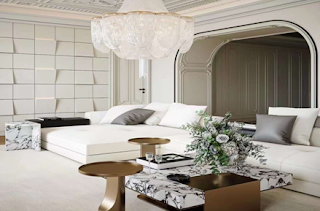5 Steps to Creating a Powerful Brand Identify for Your Interior Design Business
If you run an interior design firm and are concerned about building an extraordinary portfolio because you keep failing to draw clients, you need to concentrate on your company's brand identification.A powerful brand identity is essential for any interior design business. It helps to differentiate your business from the competition and creates a lasting impression in customers’ minds. In this article, we will discuss the five steps you need to take to create a strong brand identity.By following these steps, you can create name that stands out from the crowd and helps you build a successful interior design business. A well-planned branding strategy will ensure that people know, like, and promote your business.
To get started, you first need to come up with a name for your business. Once you have a name, you can create a logo and design a website. Once your website is up and running, you can start marketing your business and attracting new clients.
Houston3drendering.com's artists collaborate closely with customers and designers to determine their needs and objectives, and they are aware that a strong identity is crucial to making them stand out through clever branding.Are you interested in learning the steps to developing a powerful interior design brand? Then keep reading! By the end of this article, you'll have all the tools you need to start putting your brand out there and making a real impression on potential clients.
1. Know Your Target Audience
When it comes to creating a powerful brand identity, it's important to identify your audience and understand their needs. Whom are you designing for? What are their pain points? What are they looking for in a design business? Knowing what your clients hope to accomplish when engaging an interior designer is essential for a successful start.Do they desire a more opulent living room redesign? Or perhaps they are opening a new company and want to make sure that their workplace will synchronize with who they are as a company. You must understand their driving force.

Once you have a clear idea of your target customers, you can start shaping your brand around them. Moving on to the subsequent phase of pinpointing pain spots is possible from there. What concerns do potential clients have while selecting whether to engage an interior designer or which one to choose?
The demographic and psychographic characteristics of your target audience should be researched and noted. This would comprise details such as the size and type of the project, social media platforms, interests, and competitors.Following the process of pinpointing, how will your clients benefit from choosing you and your services? Consider the possibility that an interior designer can make a place both aesthetically pleasing and useful, saving the client time so they can devote it to their job or family. They will aid in preventing design errors brought on by ignorance or decision fatigue. The best furniture and design retailers can also be suggested, along with trustworthy contractors.
2. Create a Signature Look
When you're starting your own interior design business, it's important to create a signature look that customers will remember you by. This could be through a specific color palette you use or a certain type of furniture you love to work with.Whatever it is, make sure it's something that reflects your personal style and makes you stand out from the competition. You want customers to see your work and know immediately that it's from your studio.
As an interior design firm, it is important to understand your competitors in order to stay ahead of the game. Knowing your competitors’ branding, identity and other strategies can help you create a unique and competitive brand of your own that stands out from the rest. It can also help you identify potential areas of improvement for your own services. Understanding what sets you apart from your competitors is key to creating a successful interior design business.Don't be afraid to experiment until you find what works best for you. And if you ever get stuck, don't hesitate to ask for help from friends, family, or other designers in your network.

3. Leverage Social Media Platforms to Stay Connected
Utilizing social media platforms is a crucial component of creating the ideal brand identity for your interior design company. In order for your clients to feel included in the process, it is crucial that you maintain a connection with them. For starters, you should create a Facebook page or an Instagram profile to showcase different projects you have worked on, both finished and ongoing. This helps build relationships with potential clients and gives insight on your design aesthetic.
You can also use Instagram stories as a platform to share sneak peeks of your projects or live Q&As with potential customers. You might even consider creating a blog or YouTube channel where you offer tips and advice on interior design. These are great ways to reach out and connect with customers in an easy, quick manner.

Signs and advertisements in locations where your target audience is likely to congregate could be part of your offline presence. You can also use flyers to apply to get your work printed in reputable design publications. You must have perfect images for that, and www.houston3d renderings.com consistently offers the most lifelike renders, so be sure you have upper edge shots and photorealistic portrays.With just a few simple steps, you can create an effective brand identity for your interior design business that will attract customers for years to come!
4. Craft Your Brand Narrative
Once you’ve identified the values and messaging that will define your brand, it’s time to give it a personality via your brand narrative. A good starting point is to think about who your ideal customer is and what kind of experience you want them to have when working with you.

Your narrative should go beyond the basic information about who you are, what services you offer, and the areas that you serve. You want to evoke emotion by using stories and engaging content; in other words, make sure your customers know how passionate and knowledgeable you are about interior design.Be sure to include videos of yourself talking about projects or a portfolio of before-and-after photos that can tell your story in a powerful way. And don’t forget to mention awards, certifications, and positive feedback from happy clients. This will help potential customers understand why they should trust your expertise.
5. Design the Customer Experience
Now that your brand’s value proposition and target audience are identified, it’s important to better understand the customer journey. This will provide insight into how customers view and interact with your brand.
The customer journey describes how customers move through the stages of awareness, consideration, purchase, and loyalty. Consider each step along the way:From the moment they come into contact with your brand, to the moment they decide to purchase your services, you need to ensure that their journey is enjoyable and informative.However, you must first provide them with the best examples of your work in order to pique their interest in your company, whether it be through your blogs, popular design trends, or other means.This could also involve creating helpful content such as an eBook or guide to answer common questions they have, or adding incentives like discounts to encourage them to purchase faster.
There is nothing like a testimonial from a satisfied customer to show potential clients that you are trustworthy. The best way to do this is to ask the client for feedback, give them a survey, or nudge them into writing a public review. Always ask their permission before using a quote and/or photo in any public materials. Also, you’ll want to consider your approach to dealing with criticism. How will you respond if a customer is unhappy? First find out why they’re not pleased; then, if you can’t remedy it yourself, you might recommend a different vendor who can assist with the issue, redo some or all of the project, or give the client a partial refund.By understanding customers’ needs and wants at each stage of their journeys, you have a better chance at finding success with your interior design business.

If you want your interior design business to stand out from the competition, it's important to create a brand that is unique and memorable. By following these five steps, you can create a brand identity that will help your business to thrive.Create a unique brand identity for your business. Modern techniques like 3D visualization can assist you with it.
Our team of experienced 3D artists has the skills and knowledge to bring your vision to life, allowing you to showcase your products and services in the most attractive way possible. With www.houston3drenderings.com, you can be sure that all of your marketing materials and portfolio pieces will be consistent with one another, giving customers a clear understanding of what makes your business unique. Get in touch with us today to learn more about how our interior rendering services can take your marketing efforts to the next level!



Comments
Post a Comment